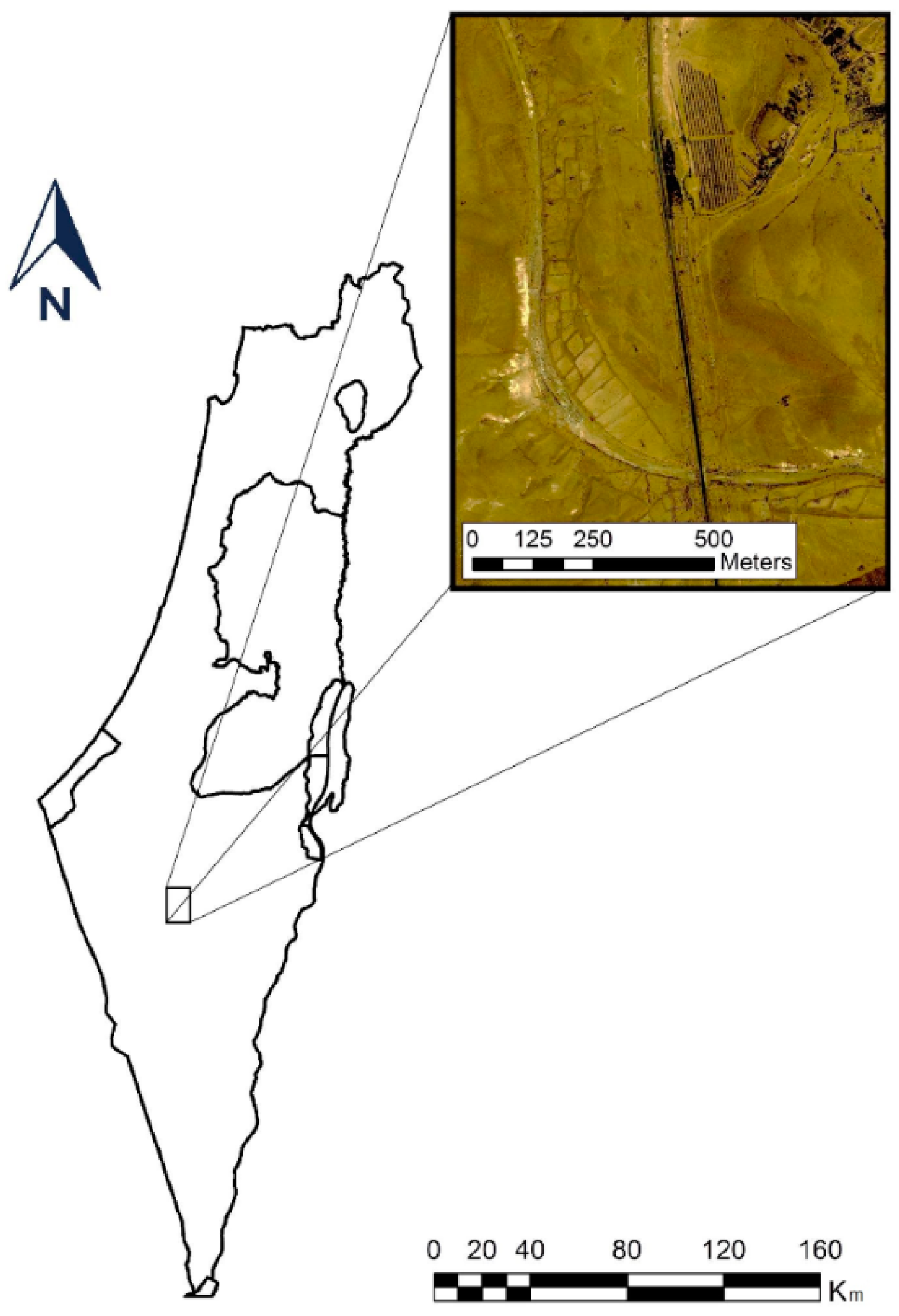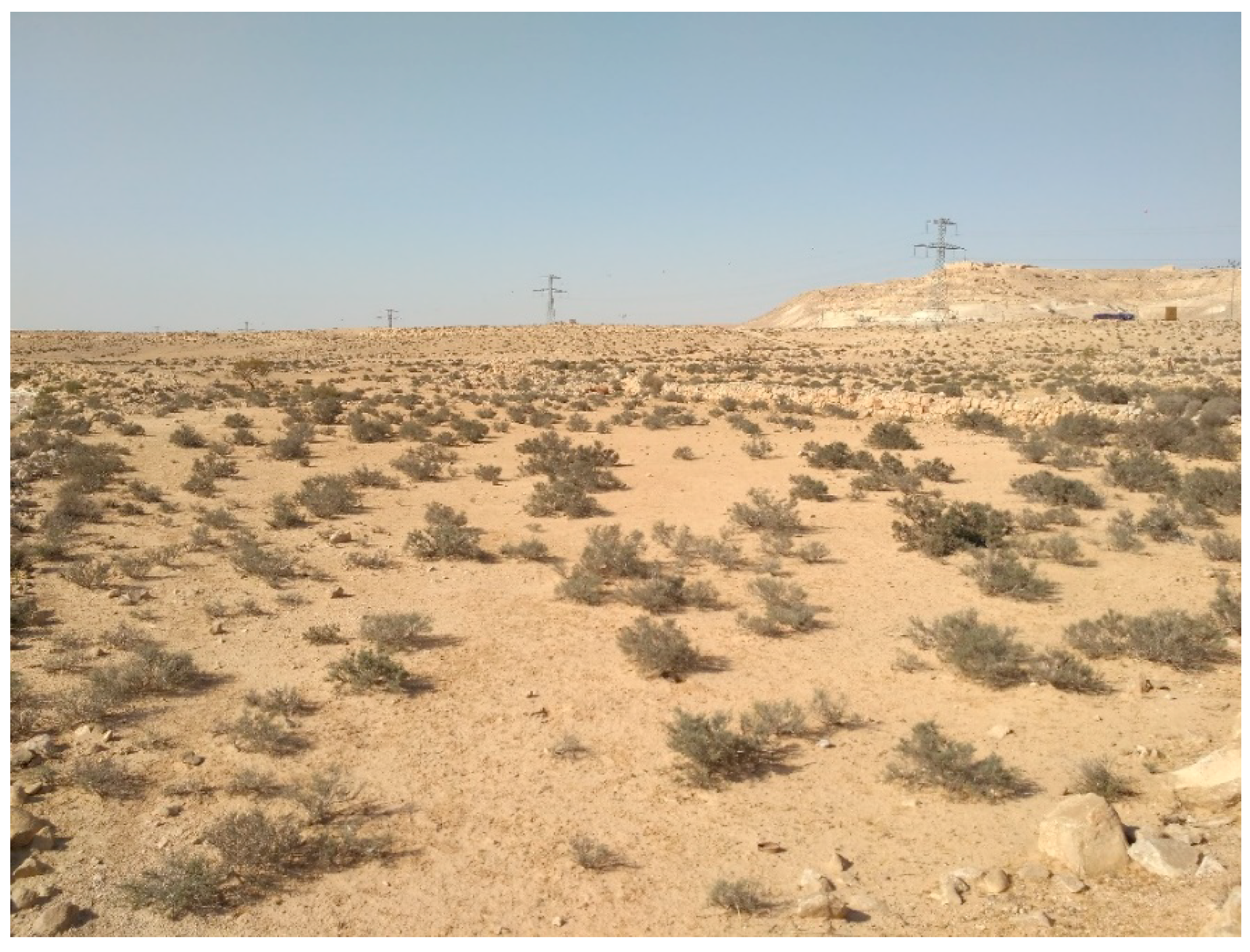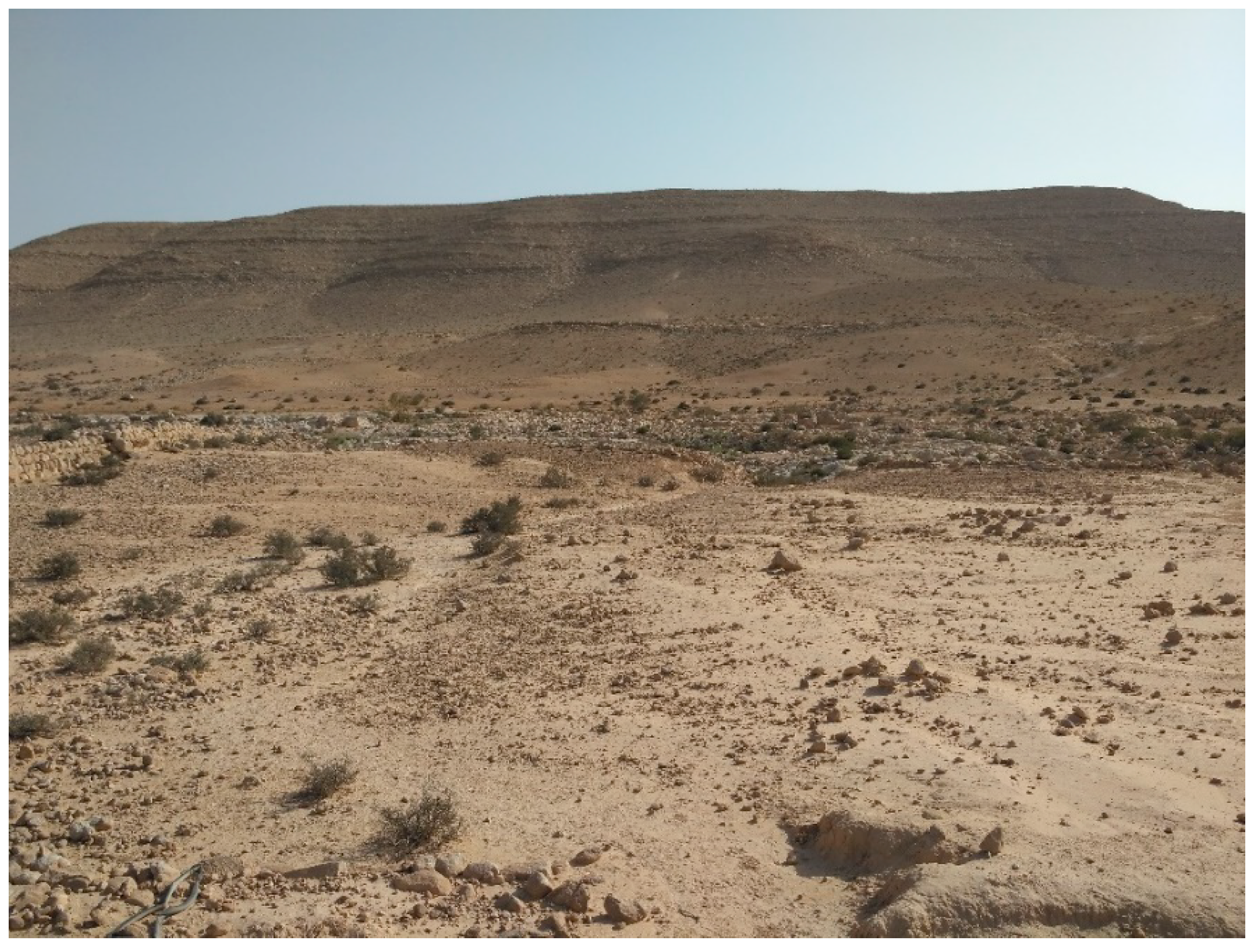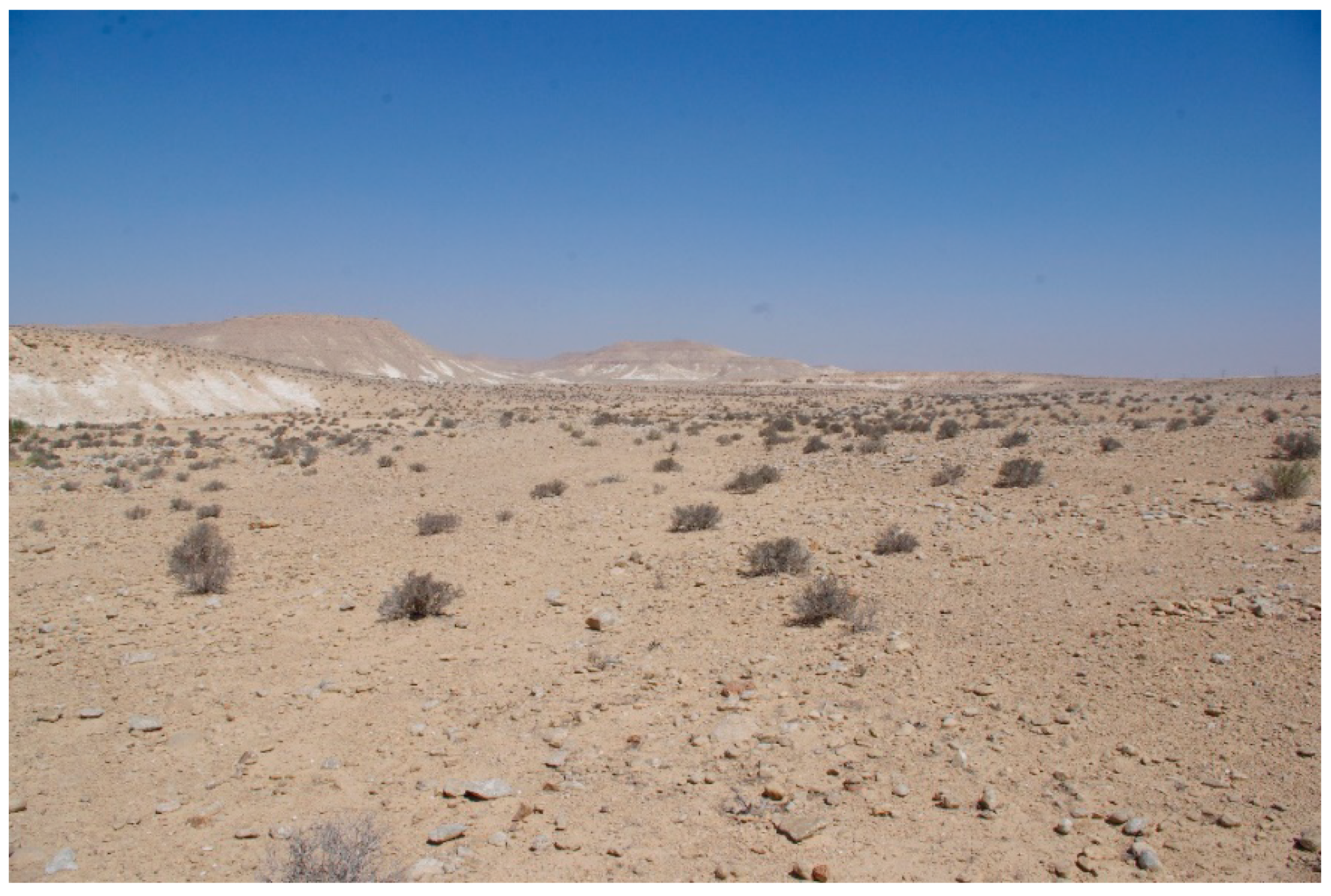Failure and Collapse of Ancient Agricultural Stone Terraces: On-Site Effects on Soil and Vegetation
Abstract
1. Introduction
2. Materials and Methods
2.1. Regional Settings
2.2. Plot Delineation and Field Work
2.3. Laboratory Analyses
2.4. Statistical Analysis
3. Results and Discussion
3.1. Ground Surface Cover and Implications for Surface Processes
3.2. Land-Use and Terrace-State Effect
3.3. Micro-Habitat Effect
3.4. Data Integration and General Implications
4. Conclusions
Author Contributions
Funding
Acknowledgments
Conflicts of Interest
References
- Vetter, T.; Reiger, A.K.; Nicolay, A. Disconnected runoff contributing areas: Evidence provided by ancient watershed management systems in arid north-eastern Marmarica (NW-Egypt). Geomorphology 2014, 212, 41–57. [Google Scholar] [CrossRef]
- Bruins, H.J. Desert Environment and Agriculture in the Central Negev and Kasech-Barnea during Historical Times. 1986. Available online: http://edepot.wur.nl/201460 (accessed on 8 October 2018).
- Ore, G.; Bruins, H.J. Design features of ancient agricultural terrace walls in the Negev desert: Human-made geodiversity. Land Degrad. Dev. 2012, 23, 409–418. [Google Scholar] [CrossRef]
- Arnáez, J.; Lana-Renault, N.; Lasanta, T.; Ruiz-Flaño, P.; Castroviejo, J. Effects of farming terraces on hydrological and geomorphological processes. A review. Catena 2015, 128, 122–134. [Google Scholar] [CrossRef]
- Lana-Renault, N.; López-Vicente, M.; Oranjuren, R.; Ángel Llorente, J.; Ruiz-Flaño, P.; Arnáez, J. Changes in hydrological connectivity due to vegetation recovery and wall collapse in abandoned terraced fields. Geophys. Res. Abstr. 2017, 19, 6878. [Google Scholar]
- Bruins, H.J. Ancient desert agriculture in the Negev and climate-zone boundary changes during average, wet and drought years. J. Arid. Environ. 2012, 86, 28–42. [Google Scholar] [CrossRef]
- Haiman, M. Dating the agricultural terraces in the southern Levantine deserts—The spatial-contextual argument. J. Arid. Environ. 2012, 86, 43–49. [Google Scholar] [CrossRef]
- Wei, W.; Chen, D.; Wang, L.; Daryanto, S.; Chen, L.; Yu, Y.; Lu, Y.; Sun, G.; Feng, T. Global synthesis of the classifications, distributions, benefits and issues of terracing. Earth Sci. Rev. 2016, 159, 388–403. [Google Scholar] [CrossRef]
- Wieler, N.; Avni, Y.; Rosensaft, M.; Olsvig-Whittaker, L. Variations in hillslope runoff as detected using geological strata coupled with vegetation patterns–Implications on spatially distributed desert runoff agriculture. J. Landsc. Ecol. 2017, 10, 189–212. [Google Scholar]
- Wertebach, T.M.; Holzel, N.; Kampf, I.; Yurtaev, A.; Tupitsin, S.; Kiehl, K.; Kamp, J.; Kleinebecker, T. Soil carbon sequestration due to post-Soviet cropland abandonment: Estimates from a large-scale soil organic carbon field inventory. Glob. Chang. Biol. 2017, 23, 3729–3741. [Google Scholar] [CrossRef] [PubMed]
- Rey Benayas, J.M.; Martins, A.; Nicolau, J.M.; Schulz, J.J. Abandonment of agricultural land: An overview of drivers and consequences. CAB Rev. Perspect. Agric. Vet. Sci. Nutr. Nat. Resour. 2007, 2, 1–14. [Google Scholar] [CrossRef]
- Calinger, K.; Calhoon, E.; Chang, H.; Whitacre, J.; Wenzel, J.; Comita, L.; Queenborough, S. Historic mining and agriculture as indicators of occurrence and abundance of widespread invasive plant species. PLoS ONE 2015, 10, e012816. [Google Scholar] [CrossRef] [PubMed]
- Shanan, L. Runoff, erosion, and the sustainability of ancient irrigation systems in the Central Negev desert. In The Hydrology-Geomorphology Interface: Rainfall, Floods, Sedimentation, Land Use; IAHS Press: Wallingford, UK, 2001. [Google Scholar]
- Agnoletti, M.; Conti, L.; Frezza, L.; Monti, M.; Santoro, A. Features analysis of dry stone walls of Tuscany (Italy). Sustainability 2015, 7, 13887–13903. [Google Scholar] [CrossRef]
- Incze, J.; Novák, T.J. Identification of extent, topographic characteristics and land abandonment process of vineyard terraces in the Tokaj-Hegyalja wine region between 1784 and 2010. J. Maps 2016, 12, 507–513. [Google Scholar] [CrossRef]
- Chapagain, T.; Raizada, M.N. Agronomic challenges and opportunities for smallholder terrace agriculture in developing countries. Front. Plant Sci. 2017, 8, 331. [Google Scholar] [CrossRef] [PubMed]
- Inbar, M.; Llerena, C.A. Erosion processes in high mountain agricultural terraces in Peru. Mt. Res. Dev. 2000, 20, 72–79. [Google Scholar] [CrossRef]
- Lesschen, J.P.; Cammeraat, L.H.; Nieman, T. Erosion and terrace failure due to agricultural land abandonment in a semi-arid environment. Earth Surf. Proc. Land. 2008, 33, 1574–1584. [Google Scholar] [CrossRef]
- Boix, C.; Calvo, A.; Imeson, A.C.; Schoorl, J.M.; Soto, S.; Tiemessen, I.R. Properties and erosional response of soils in a degraded ecosystem in Crete (Greece). Environ. Monit. Assess. 1995, 37, 79–92. [Google Scholar] [CrossRef] [PubMed]
- Brandolini, P. The outstanding terraced landscape of the Cinque Terre Coastal Slopes (Eastern Liguria). In Landscapes and Landforms of Italy; Soldati, M., Marchetti, M., Eds.; Springer: Berlin/Heidelberg, Germany, 2017. [Google Scholar]
- Tarolli, P.; Preti, F.; Romano, N. Terraced landscapes: From an old best practice to a potential hazard for soil degradation due to land abandonment. Anthropocene 2014, 6, 10–25. [Google Scholar] [CrossRef]
- Avni, Y.; Porat, N.; Plakht, J.; Avni, G. Geomorphologic changes leading to natural desertification processes versus anthropogenic land conservation in an arid environment, the Negev Highlands, Israel. Geomorphology 2006, 82, 177–200. [Google Scholar] [CrossRef]
- Avni, Y.; Weiler, N. Geological Map of Israel 1:50,000. Sde Boqer Sheet 18–IV; Geological Survey of Israel: Jerusalem, Israel, 2013.
- Bitan, A.; Rubin, S. Climatic Atlas of Israel for Physical and Environmental Planning and Design, 3rd ed.; Ramot Press: Tel Aviv, Israel, 1991. [Google Scholar]
- Israel Meteorological Service Website. Available online: http://www.ims.gov.il/IMSENG/All_Tahazit/homepage.htm (accessed on 8 October 2018).
- Herrick, J.E.; Van Zee, J.W.; Havstad, K.M.; Burkett, L.M.; Whitford, W.G. Monitoring Manual for Grassland, Shrubland and Savanna Ecosystems. Volume I: Quick Start; USDA-ARS Jornada Experimental Range: Las Cruces, NM, USA, 2005. [Google Scholar]
- Gardner, W.G. Water content. In Methods of Soil Analysis; Black, C.A., Ed.; American Society of Agronomy: Madison, WI, USA, 1965. [Google Scholar]
- McLean, E.O. Soil pH and lime requirements. In Methods of Soil Analysis, Part 2: Chemical and Microbiological Properties; Page, A.L., Ed.; American Society of Agronomy: Madison, WI, USA, 1982. [Google Scholar]
- Loeppert, R.H.; Suarez, D.L. Carbonate and gypsum. In Methods of Soil Analysis, Part 3 Chemical Methods; Sparks, D.L., Page, A.L., Helmke, P.A., Loeppert, R.H., Soltanpour, P.N., Tabatabai, M.A., Johnson, C.T., Sumner, M.E., Eds.; Soil Science Society of America: Madison, WI, USA, 1996; Volume 5. [Google Scholar]
- USDA-NRCS. Dispersive Clay Soils. EFH Notice 210-WI-62. Available online: https://prod.nrcs.usda.gov/Internet/FSE_DOCUMENTS/nrcs142p2_024606.pdf (accessed on 8 October 2018).
- Cambardella, C.A.; Elliott, E.T. Particulate soil organic matter across a grassland cultivation sequence. Soil Sci. Soc. Am. J. 1992, 56, 777–783. [Google Scholar] [CrossRef]
- Harris, D.; Horwáth, W.R.; van Kessel, C. Acid fumigation of soils to remove carbonates prior to total organic carbon or CARBON-13 isotopic analysis. Soil Sci. Soc. Am. J. 2000, 65, 1853–1856. [Google Scholar] [CrossRef]
- Nelson, D.W.; Sommers, L.E. Total carbon, organic carbon, and organic matter. In Methods of Soil Analysis, Part 2; American Society of Agronomy: Madison, WI, USA, 1996. [Google Scholar]
- Bachar, A.; Al-Ashhab, A.; Soares, M.I.M.; Sklarz, M.Y.; Angel, R.; Ungar, E.D.; Gillor, O. Soil microbial abundance and diversity along a low precipitation gradient. Microb. Ecol. 2010, 60, 453–461. [Google Scholar] [CrossRef] [PubMed]
- Firbank, L.G.; Bertora, C.; Blankman, D.; Delle Vedove, G.; Frenzel, M.; Grignani, C.; Groner, E.; Kertész, M.; Krab, E.J.; Matteucci, G.; et al. Towards the co-ordination of terrestrial ecosystem protocols across European research infrastructures. Ecol. Evol. 2017, 7, 3967–3975. [Google Scholar] [CrossRef] [PubMed]
- SAS Institute. SAS/STAT User’s Guide. Version 6, 4th ed.; SAS Institute: Cary, NC, USA, 1990. [Google Scholar]
- Ratzmann, G.; Gangkofner, U.; Tietjen, B.; Fenshol, R. Dryland vegetation functional response to altered rainfall amounts and variability derived from satellite time series data. Remote Sens. 2016, 8, 1026. [Google Scholar] [CrossRef]
- García-Ruiz, J.M.; Lana-Renault, N. Hydrological and erosive consequences of farmland abandonment in Europe, with special reference to the Mediterranean region—A review. Agric. Ecosyst. Environ. 2011, 140, 317–338. [Google Scholar] [CrossRef]
- Koulouri, M.; Giourga, C. Land abandonment and slope gradient as key factors of soil erosion in Mediterranean terraced lands. Catena 2007, 69, 274–281. [Google Scholar] [CrossRef]
- Stavi, I.; Rachmilevitch, S.; Hjazin, A.; Yizhaq, H. Geodiversity decreases shrub mortality and increases ecosystem tolerance to droughts and climate change. Earth Surf. Proc. Land. 2018, 43, 2808–2817. [Google Scholar] [CrossRef]
- Tromble, J.M. Water interception by two arid land shrubs. J. Arid Environ. 1988, 15, 65–70. [Google Scholar] [CrossRef]
- Hofmann, L.; Ries, R.E. Relationship of soil and plant characteristics to erosion and runoff on pasture and range. J. Soil Water Conserv. 1991, 46, 143–147. [Google Scholar]
- Tongway, D.J.; Ludwig, J.A. The conservation of water and nutrients within landcapes. In Landscape Ecology Function and Management; Ludwig, J.A., Tongway, D.J., Freudenberger, D., Noble, J., Hodgkinson, K., Eds.; CSIRO Publishing: Collingwood, Australia, 2003; pp. 13–22. [Google Scholar]
- Stavi, I.; Lavee, H.; Ungar, E.D.; Sarah, P. Eco-geomorphic feedbacks in semi-arid rangelands: A review. Pedosphere 2009, 19, 217–229. [Google Scholar] [CrossRef]
- Puigdefábregas, J. The role of vegetation patterns in structuring runoff and sediment fluxes in drylands. Earth Surf. Proc. Land. 2005, 30, 133–147. [Google Scholar] [CrossRef]
- Diedhiou-Sall, S.; Dossa, E.L.; Diedhiou, I.; Badiane, A.N.; Assigbetse, K.B.; Samba, S.A.N.; Khouma, M.; Sene, M.; Dick, R.P. Microbiology and macrofaunal activity in soil beneath shrub canopies during residue decomposition in agroecosystems of the Sahel. Soil Sci. Soc. Am. J. 2013, 77, 501–511. [Google Scholar] [CrossRef]
- Larney, F.J.; Angers, D.A. The role of organic amendments in soil reclamation: A review. Can. J. Soil Sci. 2012, 92, 19–38. [Google Scholar] [CrossRef]
- Poesen, J.; Ingelmo-Sanchez, F. Runoff and sediment yield from topsoils with different porosity as affected by rock fragment cover and position. Catena 1992, 19, 451–474. [Google Scholar] [CrossRef]
- Lavee, H.; Poesen, J. Overland flow generation and continuity on stone-covered soil surface. Hydrol. Processes 1991, 5, 345–360. [Google Scholar] [CrossRef]
- Stavi, I.; Argaman, E.; Zaady, E. Positive impact of moderate stubble grazing on soil quality and organic carbon pool in dryland wheat agro-pastoral systems. Catena 2016, 146, 94–99. [Google Scholar] [CrossRef]
- Morgan, R.P.C. Soil Erosion and Conservation, 3rd ed.; Blackwell Publishing: Malden, MA, USA, 2005. [Google Scholar]
- Crouvi, O.; Amit, R.; Enzel, Y.; Gillespie, A.R. Active sand seas and the formation of desert loess. Quat. Sci. Rev. 2010, 29, 2087–2098. [Google Scholar] [CrossRef]
- Zwikel, S. Spatial Patterns of Soil Properties Which Affect Water Regime (Rainfall Overland Flow Relationships) in Eco-Geomorphic Systems along a Climatic Transect, from the Negev Highlands to the Galilee Mountains. Ph.D. Thesis, Bar-Ilan University, Ramat Gan, Israel, 2004. [Google Scholar]
- Cerdà, A.; Burguet, M.; Keesstra, S.; Prosdocimi, M.; Di Prima, S.; Brevik, E.; Novara, A.; Jordan, A.; Tarolli, P. The impact of agriculture terraces on soil organic matter, aggregate stability, water repellency and bulk density. A study in abandoned and active farms in the Sierra de Enguera, Eastern Spain. Geophys. Res. Abstr. 2016, 25, 288–296. [Google Scholar]
- Oades, J.M. Soil organic matter and structural stability: Mechanisms and implications for management. Plant Soil 1984, 76, 319–337. [Google Scholar] [CrossRef]
- Amézketa, E. Soil aggregate stability: A review. J. Sustain. Agric. 1999, 14, 83–151. [Google Scholar] [CrossRef]
- Smith, J.C.; Galy, A.; Hovius, N.; Tye, A.M.; Turowski, J.M.; Schleppi, P. Runoff-driven export of particulate organic carbon from soil in temperate forested uplands. Earth Planet. Sci. Lett. 2013, 365, 198–208. [Google Scholar] [CrossRef]
- Wang, X.; Cammeraat, E.L.H.; Romeijn, P.; Kalbitz, K. Soil organic carbon redistribution by water erosion—The role of CO2 emissions for the carbon budget. PLoS ONE 2014, 9, e96299. [Google Scholar] [CrossRef] [PubMed]
- Hermans, S.M.; Buckley, H.L.; Case, B.S.; Curran-Cournane, F.; Taylor, M.; Lear, G. Bacteria as emerging indicators of soil conditions. Appl. Environ. Microbiol. 2017, 83, e02826-16. [Google Scholar] [CrossRef] [PubMed]
- Karim, B.; Mukhtar, A.; Mukhtar, H.; Makshoof, A. Effect of the canopy cover on the organic and inorganic content of soil in Cholistan Desert. Pak. J. Bot. 2009, 41, 2387–2395. [Google Scholar]
- Todd, S.D. Re-Vegetation and Rehabilitation Plan. 2013. Available online: https://www.erm.com/contentassets/ef51f6123d3d436bb2e3c5207b971595/sub-appendices/appendix-c.pdf (accessed on 8 October 2018).
- Aitken, R.L. Relationships between extractable Al, selected soil properties, pH buffer capacity and lime requirement in some acidic Queensland soils. Aust. J. Soil Res. 1992, 30, 119–130. [Google Scholar] [CrossRef]
- Bloom, P.R. Soil pH and pH buffering. In Handbook of Soil Science; Sumner, M.E., Ed.; CRC Press: Boca Raton, FL, USA, 2000. [Google Scholar]
- Costantini, E.A.C.; Branquinho, C.; Nunes, A.; Schwilch, G.; Stavi, I.; Valdecantos, A.; Zucca, C. Soil indicators to assess the effectiveness of restoration strategies in dryland ecosystems. Solid Earth 2016, 7, 397–414. [Google Scholar] [CrossRef]
- Pearse, C.K. Grazing in the Middle East: Past, present, and future. J. Range Manag. 1971, 24, 13–16. [Google Scholar] [CrossRef]
- Hardin, G. The tragedy of the commons. Science 1968, 162, 1243–1248. [Google Scholar] [CrossRef] [PubMed]
- Seneviratne, S.I.; Nicholls, N.; Easterling, D.; Goodess, C.M.; Kanae, S.; Kossin, J.; Luo, Y.; Marengo, J.; McInnes, K.; Rahimi, M.; et al. Changes in climate extremes and their impacts on the natural physical environment. In Managing the Risks of Extreme Events and Disasters to Advance Climate Change Adaptation; A Special Report of Working Groups I and II of the Intergovernmental Panel on Climate Change (IPCC); Field, C.B., Barros, V., Stocker, T.F., Qin, D., Dokken, D.J., Ebi, K.L., Mastrandrea, M.D., Mach, K.J., Plattner, G.K., Allen, S.K., et al., Eds.; Cambridge University Press: Cambridge, UK, 2012; pp. 109–230. [Google Scholar]
- Ummenhofer, C.C.; Meehl, G.A. Extreme weather and climate events with ecological relevance: A review. Philos. Trans. R. Soc. B 2017, 372, 20160135. [Google Scholar] [CrossRef] [PubMed]
- Thematic Group on Sustainable Agriculture and Food Systems of the Sustainable Development Solutions Network. Solutions for Sustainable Agriculture and Food Systems—Technical Report for the Post-2015 Development Agenda. 2013. Available online: http://unsdsn.org/wp-content/uploads/2014/02/130919-TG07-Agriculture-Report-WEB.pdf (accessed on 8 October 2018).




| p Value | Entire Terraces | Collapsed Terraces | Natural Land | |
|---|---|---|---|---|
| Haloxylon scoparium | <0.0001 | 13.4 a (2.0) | 1.4 b (0.6) | 5.2 b (0.8) |
| Zygophyllum dumosum | 0.1541 | 0.0 a (0.0) | 0.0 a (0.0) | 0.7 a (0.5) |
| Artemisia herba-alba | 0.2194 | 0.4 a (0.3) | 0.0 a (0.0) | 0.0 a (0.0) |
| Total shrub cover | <0.0001 | 10.3 a (1.7) | 1.1 c (0.5) | 4.8 b (0.7) |
| Herbaceous vegetation | 0.002 | 2.0 a (0.6) | 0.0 b (0.0) | 0.6 b (0.3) |
| Plant litter | 0.0019 | 5.0 a (1.3) | 0.2 b (0.2) | 1.8 b (0.4) |
| Partially-embedded rock fragments | <0.0001 | 1.8 c (0.6) | 11.8 b (3.4) | 29.8 a (1.8) |
| Resting rock fragments | <0.0001 | 0.9 c (0.3) | 8.1 b (2.7) | 36.0 a (1.3) |
| Exposed soil | <0.0001 | 75.8 a (2.3) | 78.2 a (5.8) | 25.9 b (1.6) |
| Other | 0.221 | 0.7 a (0.2) | 0.3 a (0.1) | 0.0 a (0.0) |
| p Value | Entire Terraces | Collapsed Terraces | Natural Land | |
|---|---|---|---|---|
| Gravimetric SM (%) | 0.0223 | 2.5 a (0.2) | 2.1 ab (0.2) | 1.8 b (0.1) |
| Calcium carbonate (%) | <0.0001 | 37.7 b (0.7) | 40.3 a (1.0) | 33.1 c (0.8) |
| pH | 0.014 | 8.0 b (0.1) | 8.2 a (0.1) | 8.2 a (0.1) |
| Aggregate stability (%) | 0.0041 | 24.8 a (2.7) | 16.1 b (2.5) | 17.6 b (2.1) |
| Clay dispersion index | 0.0451 | 2.71 b (0.29) | 3.42 a (0.24) | 3.41 a (0.22) |
| Particulate organic carbon (g kg−1) | 0.0282 | 5.5 ab (0.7) | 4.7 b (1.0) | 6.3 a (0.4) |
| Relative microbial abundance (16S rDNA fragment number g−1) | <0.0001 - | 2.52 × 108 a (1.59 × 107) | 1.42 × 108 b (2.42 × 107) | 1.37 × 108 b (2.29 × 107) |
| Mesofaunal abundance (#) | 0.0158 | 23.1 ab (5.5) | 26.9 a (8.2) | 10.3 b (2.4) |
| p Value | Shrubby Patches | Inter-Shrub Spaces | |
|---|---|---|---|
| Gravimetric SM (%) | 0.6582 | 2.1 a (0.2) | 2.2 a (0.1) |
| Calcium carbonate (%) | 0.473 | 37.3 a (0.8) | 36.8 a (0.9) |
| pH | <0.0001 | 8.0 b (0.1) | 8.3 a (0.1) |
| Aggregate stability (%) | <0.0001 | 25.9 a (2.0) | 13.1 b (1.4) |
| Clay dispersion index | 0.0009 | 2.72 b (0.23) | 3.64 a (0.14) |
| Particulate organic carbon (g kg−1) | 0.0018 | 6.4 a (0.3) | 4.6 b (0.7) |
| Relative microbial abundance (16S rDNA fragment number g−1) | <0.0001 - | 2.13 × 108 a (2.19 × 107) | 1.41 × 108 b (1.51 × 107) |
| Mesofaunal abundance (#) | <0.0001 | 31.0 a (5.3) | 9.1 b (1.9) |
| Particulate Organic Carbon (g kg−1) | Mesofaunal Abundance | |
|---|---|---|
| p Value | 0.0088 | 0.024 |
| Entire terraces × shrubby patches | 6.3 a (0.7) | 30.8 ab (9.3) |
| Entire terraces × inter-shrub spaces | 4.6 ab (1.0) | 13.4 bc (4.1) |
| Collapsed terraces × shrubby patches | 6.6 a (0.3) | 47.1 a (6.4) |
| Collapsed terraces × inter-shrub spaces | 2.8 b (1.0) | 6.6 c (1.5) |
| Natural land × shrubby patches | 6.2 a (0.6) | 15.3 bc (3.3) |
| Natural land × inter-shrub spaces | 6.4 a (0.5) | 5.3 c (0.4) |
© 2018 by the authors. Licensee MDPI, Basel, Switzerland. This article is an open access article distributed under the terms and conditions of the Creative Commons Attribution (CC BY) license (http://creativecommons.org/licenses/by/4.0/).
Share and Cite
Stavi, I.; Rozenberg, T.; Al-Ashhab, A.; Argaman, E.; Groner, E. Failure and Collapse of Ancient Agricultural Stone Terraces: On-Site Effects on Soil and Vegetation. Water 2018, 10, 1400. https://doi.org/10.3390/w10101400
Stavi I, Rozenberg T, Al-Ashhab A, Argaman E, Groner E. Failure and Collapse of Ancient Agricultural Stone Terraces: On-Site Effects on Soil and Vegetation. Water. 2018; 10(10):1400. https://doi.org/10.3390/w10101400
Chicago/Turabian StyleStavi, Ilan, Tamir Rozenberg, Ashraf Al-Ashhab, Eli Argaman, and Elli Groner. 2018. "Failure and Collapse of Ancient Agricultural Stone Terraces: On-Site Effects on Soil and Vegetation" Water 10, no. 10: 1400. https://doi.org/10.3390/w10101400
APA StyleStavi, I., Rozenberg, T., Al-Ashhab, A., Argaman, E., & Groner, E. (2018). Failure and Collapse of Ancient Agricultural Stone Terraces: On-Site Effects on Soil and Vegetation. Water, 10(10), 1400. https://doi.org/10.3390/w10101400








